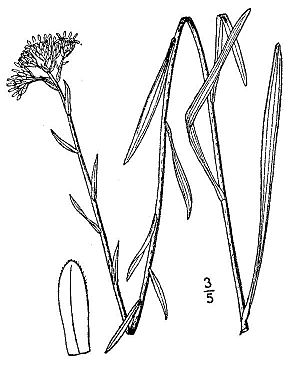Solidago houghtonii facts for kids
Quick facts for kids Solidago houghtonii |
|
|---|---|
 |
|
| 1913 illustration | |
| Conservation status | |
| Scientific classification | |
| Genus: |
Solidago
|
| Species: |
houghtonii
|
| Synonyms | |
|
|
Houghton's goldenrod (scientific name: Solidago houghtonii) is a special and rare flowering plant. It belongs to the aster family, which also includes sunflowers and daisies. This plant grows naturally in North America, specifically in southern Ontario, Canada, and parts of the northern United States like Michigan and New York.
Sadly, Houghton's goldenrod is in danger. Its home is shrinking and getting damaged. Because of this, it is listed as a threatened species in the United States. Canada also considers it a species of special concern. This means people are working to protect it.
Contents
What Does Houghton's Goldenrod Look Like?
Houghton's goldenrod is a plant that comes back year after year. It grows one or more straight stems that can reach up to 60 centimeters (about 2 feet) tall. The bottom part of the plant has old leaf remains.
- The leaves near the ground are shaped like ovals.
- Leaves higher up the stem are long and narrow, like a spear. They can be up to 18 centimeters (about 7 inches) long.
The plant has many small flower heads grouped together. Each flower head is about one centimeter long. Inside each head, you'll find:
- 6 to 12 bright yellow ray florets (these look like petals).
- Several yellow disc florets (these are in the center).
When the plant makes seeds, each seed is about half a centimeter long. It has a fluffy top, like a tiny parachute, which helps it fly away in the wind. Houghton's goldenrod usually blooms in August.
How Was This Plant Named?
Scientists first described Houghton's goldenrod in 1848. Two famous botanists, John Torrey and Asa Gray, gave it the name Solidago houghtonii.
Later, in 1993, another scientist named Guy Nesom thought it might fit better in a different group of plants called Oligoneuron. So, some people now call it Oligoneuron houghtonii. However, many still use the original name, Solidago houghtonii. It's all part of how scientists organize and understand plants.
The plant is named after Douglass Houghton. He was a doctor, botanist, and geologist. He found this plant in 1839 near Lake Michigan in Mackinac County, Michigan.
Where Does Houghton's Goldenrod Live?
Houghton's goldenrod loves to grow near the shores of the Great Lakes. You can mostly find it around Lake Huron and Lake Michigan. It's also found near the Michigan-Ontario border, close to Sault Ste. Marie.
This plant prefers sandy areas along the lakeshore. It also grows in moist limestone alvars. Alvar is a special type of land with thin soil over limestone rock. Sometimes, its habitat gets covered by water, but the plants can grow back when the water levels drop. It can also be found in wet, spongy bogs.
Why Is This Plant in Danger?
Houghton's goldenrod is threatened by many things that harm its home.
- Losing its home: When people build new things or develop land, the plant's habitat is destroyed or broken into smaller pieces.
- Damaged dunes: The plant often grows among sand dunes. Any disturbance to these dunes, like people driving off-road vehicles on them, can hurt the plants.
- New structures: Building walls, roads, and other structures near the shore also damages the dunes and the plant's habitat.
- Maintenance activities: Things like spraying herbicides (weed killers), mowing, or using salt on roads can harm the plants.
- Beach fun: Even too much recreation on the beaches can disturb the plant's delicate environment.
Since 1975, about 20% of all the places where this plant used to grow have been lost. This is why it's so important to protect Houghton's goldenrod and its unique habitat.


